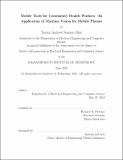| dc.contributor.advisor | Richard R. Fletcher. | en_US |
| dc.contributor.author | Soriano Díaz, Xavier Andrew | en_US |
| dc.contributor.other | Massachusetts Institute of Technology. Department of Electrical Engineering and Computer Science. | en_US |
| dc.date.accessioned | 2018-12-18T19:46:46Z | |
| dc.date.available | 2018-12-18T19:46:46Z | |
| dc.date.copyright | 2018 | en_US |
| dc.date.issued | 2018 | en_US |
| dc.identifier.uri | http://hdl.handle.net/1721.1/119710 | |
| dc.description | Thesis: M. Eng., Massachusetts Institute of Technology, Department of Electrical Engineering and Computer Science, 2018. | en_US |
| dc.description | This electronic version was submitted by the student author. The certified thesis is available in the Institute Archives and Special Collections. | en_US |
| dc.description | Cataloged from student-submitted PDF version of thesis. | en_US |
| dc.description | Includes bibliographical references (pages 111-115). | en_US |
| dc.description.abstract | According to a recent report from the World Health Organization (WHO) and the World Bank, as many as half of the world's population lack access to essential health services [1], a factor that contributes to the deaths of more than 5 million children every year. To tackle these problems, countries like India have set in motion a number of initiatives, such as that of Community Health Workers (CHW). However, CHWs feel disempowered as they often lack access to convenient and reliable tools to perform their measurements. In this thesis, we first propose a number of mobile tools that make use of the smartphone camera, combined with machine vision and augmented reality (AR) to extract, collect and analyze data from the image of the child, and provide the CHW with an accurate, faster and automated means of performing Neonatal and Child Health (NCH) measurements, while at the same time, revealing relevant feedback about the health of the patient. The basic measurements include anthropometric information such as Length, Weight and Middle Upper Arm Circumference (MUAC). For initial deployment and field testing of the technology, we partnered with the Public Health Foundation of India (PHFI), which implements much of the training for their accredited social health activists (ASHA). Since the ASHA health worker program is a government program, we obtained approval from the Government of India and conducted a pilot usability study with 13 ASHA workers in the New Delhi slums using our technology, between the months of May and September of 2017. For the study, we created Baby Naapp, an Android application that served as an interface for the ASHA workers to create basic profiles with socio-economic information of their patients, and to perform calls to each of our measurement tools. The findings of this study helped to refine our algorithms and the user experience of our apps. Additionally, we have also explored the use of multi-spectral sensing to capture essential physiological measurements. We have developed an Android mobile application which uses a thermal camera module to automatically measure respiration rate (RR) and respiration rate variability (RRV). This app makes use of machine vision algorithms to detect a human face and then measure the temperature fluctuations in the nostrils to approximate air flow rates and calculate timing parameters. Future research will improve the accuracy of the anthropometric measurement tools by refining the machine vision algorithms and the hardware used to capture the readings, and will also include the thermal respiration app into the NCH kit. The data capturing algorithm will be used to develop a jaundice screening tool, and the data structures created to organize and analyze measurements in the NCH kit can be incorporated into the other verticals of our lab, such as the pulmonary and cardiovascular screening tools. | en_US |
| dc.description.statementofresponsibility | by Xavier Andrew Soriano Díaz. | en_US |
| dc.format.extent | 115 pages | en_US |
| dc.language.iso | eng | en_US |
| dc.publisher | Massachusetts Institute of Technology | en_US |
| dc.rights | MIT theses are protected by copyright. They may be viewed, downloaded, or printed from this source but further reproduction or distribution in any format is prohibited without written permission. | en_US |
| dc.rights.uri | http://dspace.mit.edu/handle/1721.1/7582 | en_US |
| dc.subject | Electrical Engineering and Computer Science. | en_US |
| dc.title | Mobile tools for community health workers : an application of machine vision for mobile phones | en_US |
| dc.type | Thesis | en_US |
| dc.description.degree | M. Eng. | en_US |
| dc.contributor.department | Massachusetts Institute of Technology. Department of Electrical Engineering and Computer Science | |
| dc.identifier.oclc | 1078409966 | en_US |
